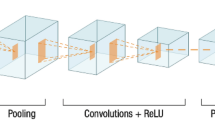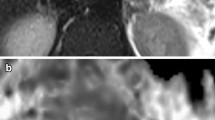Abstract
Cine magnetic resonance imaging (MRI) analysis methods are used to diagnose peritonitis, a life-threatening disease associated with decreased intestinal peristalsis. However, variable reproducibility of Cine MRI assessment tests of bowel peristalsis is a critical issue that needs to be improved. Computer-aided diagnosis could help address this issue; however, it faces a number of challenges: the need to extract temporal and spatial features from Cine MRI and the need to extract both global and local features. In this paper, we apply the deep optical flow network (DOFN), an optical flow calculation (TV-L1 method) method based on deep learning for the diagnosis of peritonitis. In the proposed method, the Cine MRI temporal frames serve as input to the DOFN method for optical flow computations of the abdominal region. The computed optical flows are used as global temporal and spatial features for diagnosing peritonitis. In addition, we divide the abdominal region into four subregions. We then proceed with calculating the optical flow and classifying peritonitis in each subregion. The final decision is made based on the results extracted from the four subregions. Furthermore, we visualize the small bowel motility through the computed optical flow. The area under the curve of the proposed method is about 0.72 even without administering contrast media intravenously.
Access this chapter
Tax calculation will be finalised at checkout
Purchases are for personal use only
Similar content being viewed by others
References
Wakamiya, M., Furukawa, A., Kanasaki, S., Murata, K.: Assessment of small bowel motility function with cine-MRI using balanced steady-state free precession sequence. J. Magn. Reson. Imaging 33, 1235–1240 (2011)
Inoue, A., et al.: Acceleration of small bowel motility after oral administration of dai-kenchu-to (TJ-100) assessed by cine magnetic resonance imaging. PLoS One 13(1), e0191044 (2018). https://doi.org/10.1371/journal.pone.0191044.eCollection2018
Otsuki, K.: Small bowel region extraction and peristaltic analysis of abdominal cine-MRI using deep learning to differentiate peritonitis. Master thesis of Graduate School of Information Science and Engineering, Ritsumeikan University
Ronneberger, O., Fischer, P., Brox, T.: U-Net: convolutional networks for biomedical image segmentation. MICCAI2015, pp. 243–241 (2015)
Cicek, O., Abdulkadir, A., Lienkamp, S.S., Brox, T., Ronneberger, O.: 3D U-Net: learning dense volumetric segmentation from sparse annotation. MICCAI2016, pp. 424–432 (2016)
Otsuki, K., et al.: Cine MR image segmentation for assessment of small bowel motility function using 3D U-Net. J. Image Graph. 7, 134–139 (2019)
Zach, C., Pock, T., Bischof, H.: A duality based approach for realtime TV-L 1 optical flow. Pattern Recogn. 1(1), 214–223 (2007)
Lucas, B., Kanade, T.: An iterative image registration technique with an application to stereo vision. In: International Joint Conference on Artificial Intelligence, pp. 674–679 (1981)
Horn, B., Schunck, B.: Determining optical flow. Artif. Intell. 17(1–3), 185–203 (1981)
Revaud, J., et al.: Epicflow: edge-preserving interpolation of correspondences for optical flow. In: Proceedings of the IEEE Conference on Computer Vision and Pattern Recognition, pp. 1164–1172 (2015)
Dosovitskiy, A., et al.: Flownet: learning optical flow with convolutional networks. In: Proceedings of the IEEE International Conference on Computer Vision, pp. 2758–2766 (2015)
Ilg, E., et al.: Flownet 2.0: evolution of optical flow estimation with deep networks. In: Proceedings of the IEEE Conference on Computer Vision and Pattern Recognition, pp. 2462–2470 (2017)
Guan, S., Li, H., Zheng, W.-S.: Unsupervised learning for optical flow estimation using pyramid convolution lstm. In: 2019 IEEE International Conference on Multimedia and Expo (ICME). IEEE, pp. 181–186 (2019)
Piergiovanni, A.J., Ryoo, M.S.: Representation flow for action recognition. In Proceedings of the IEEE Conference on Computer Vision and Pattern Recognition (CVPR) (2019)
He, K., Zhang, X., Ren, S., Sun, J.: Deep residual learning for image recognition. In: Proceedings of the IEEE Conference on Computer Vision and Pattern Recognition, pp. 770–778 (2016)
Fan, L., Huang, W., Gan, S.E.C., Gong, B., Huang, J.: End-to-end learning of motion representation for video understanding. In: Proceedings of the IEEE Conference on Computer Vision and Pattern Recognition (CVPR) (2018)
Sun, S., Kuang, Z., Sheng, L., Ouyang, W., Zhang, W.: Optical flow guided feature: a fast and robust motion representation for video action recognition. In: Proceedings of the IEEE Conference on Computer Vision and Pattern Recognition (CVPR) (2018)
Youden, W.J.: Index for rating diagnostic tests. Cancer 3, 32–35 (1950)
Acknowledgements
This work was supported in part by the Grant-in Aid for Scientific Research from the Japanese Ministry for Education, Science, Culture and Sports (MEXT) under Grant No. 20KK0234 and No. 20K21821.
Author information
Authors and Affiliations
Corresponding author
Editor information
Editors and Affiliations
Rights and permissions
Copyright information
© 2021 The Author(s), under exclusive license to Springer Nature Singapore Pte Ltd.
About this paper
Cite this paper
Kawahara, T., Inoue, A., Iwamoto, Y., Furukawa, A., Chen, YW. (2021). Computer-Aided Diagnosis of Peritonitis on Cine-MRI Using Deep Optical Flow Network. In: Chen, YW., Tanaka, S., Howlett, R.J., Jain, L.C. (eds) Innovation in Medicine and Healthcare. Smart Innovation, Systems and Technologies, vol 242. Springer, Singapore. https://doi.org/10.1007/978-981-16-3013-2_17
Download citation
DOI: https://doi.org/10.1007/978-981-16-3013-2_17
Published:
Publisher Name: Springer, Singapore
Print ISBN: 978-981-16-3012-5
Online ISBN: 978-981-16-3013-2
eBook Packages: Intelligent Technologies and RoboticsIntelligent Technologies and Robotics (R0)




